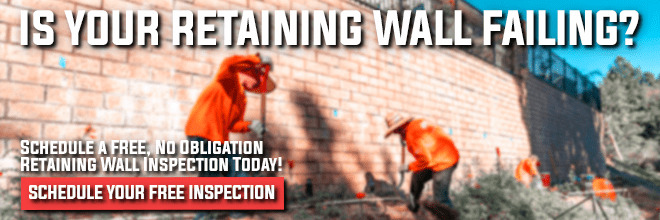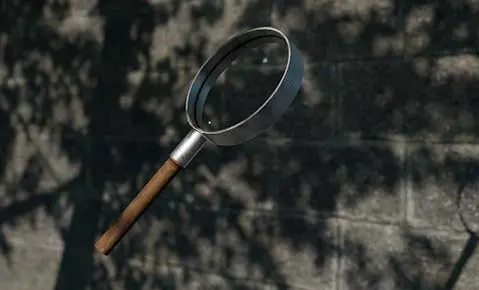Generally speaking, the California average cost for a retaining wall is anywhere between $300-$900 per linear foot. Keep reading to learn how to break down the math, it just might be cheaper than you think depending on the scope of the project.
We offer financing –
What is a retaining wall?A retaining wall is a strong, solid barrier utilized to support soil laterally so as to “retain” the soil at two separate levels on either border. These structures are designed to harness soil to a slope that would otherwise naturally not exist. Retaining walls are used to mitigate soil failure and are a favorite form of slope stabilization. Retaining walls used to separate water from land are called bulkheads. |
Retaining walls are utilized for a variety of reasons, including:
- Landslide Prevention
- Property Expansion
- Creating a barrier against bodies of water (a bulkhead)
- Garden Aesthetics
- Slope Stabilization
Whether you’re concerned your home will go sailing downhill after an earthquake or just take its slow sweet geological time inching along with gravity, a retaining wall is a great line of defense against slope creep.
Retaining walls intercept the slope, take the load, and hold it in place.
This article is going to cover:
- Cost of Building a New Retaining Wall
- Cost of Repairing a Retaining Wall
Retaining walls can secure one of your greatest financial investments: your home. New retaining walls, while they can be pricey, are worth the investment because it keeps your home and family safe.
If, for example, action is not taken soon enough, homes can be condemned/red-tagged due to lack of sooner slope stabilization. We here at Dalinghaus believe it is worth the price for peace of mind.
*Note – check out our exhaustive Ultimate Guide To Foundation Repair.
Cost of Retaining of New Retaining Wall
To reiterate, the cost of a brand-spankin’ new retaining wall comes out to about $300 to $900 per linear foot for a California / Central Arizona average.
In the table below, we are going to utilize the higher end of the financial spectrum and use 6 feet as our average depth.
We are doing this because (a. the majority of the new retaining wall jobs we see cost well over $12,000 and we want to give you an accurate picture and (b. because 6 feet is the average depth, we utilize here in Southern California based on engineer design.
*Note – Height is always based on structural engineer designs and/or a city cut that are made available to the contractor. Therefore: cost is always generated off of engineer design by default.
Retaining Wall Length x Depth = Estimated Cost ($300 per linear foot)
10 x 6-feet (60 LF.)
20 x 6-feet (120 LF.)
25 x 6-feet (150 LF.)
30 x 6-feet (180 LF.)
50 x 6-feet (300 LF.) | $18,000
$36,000
$45,000
$54,000
$90,000 |
In addition to the price per linear foot, Permitting can cost anywhere from $1000 to $4000 depending on your state, city, or county.
Fun Facts with Brian – A retaining wall retains while a perimeter wall subdivides properties.
Retaining Wall Repair Factors
There are a couple of factors you want to consider when trying to decide if you do, in fact, require a retaining wall repair.
- The amount of lean
- Age of wall (retaining walls generally only last 50 to 90 years)
- Size of footing (was it large enough to adequately sustain the load)
- Type of Soil (expansive soil can push out your retaining wall)
- Type of hillside/slant (how steep is the gradient)
- If it was properly made in the first place (The Contractor Repair Industry is full of space cadets).
We can occasionally rotate the wall back into place, but we have to first fully excavate behind a wall, push it back, and then hold it in place.
However, this is a very difficult and very expensive option. We can and do still utilize helical tiebacks on a leaning wall and see great results; however, it is typically more cost efficient to demo it out if the lean is too severe.
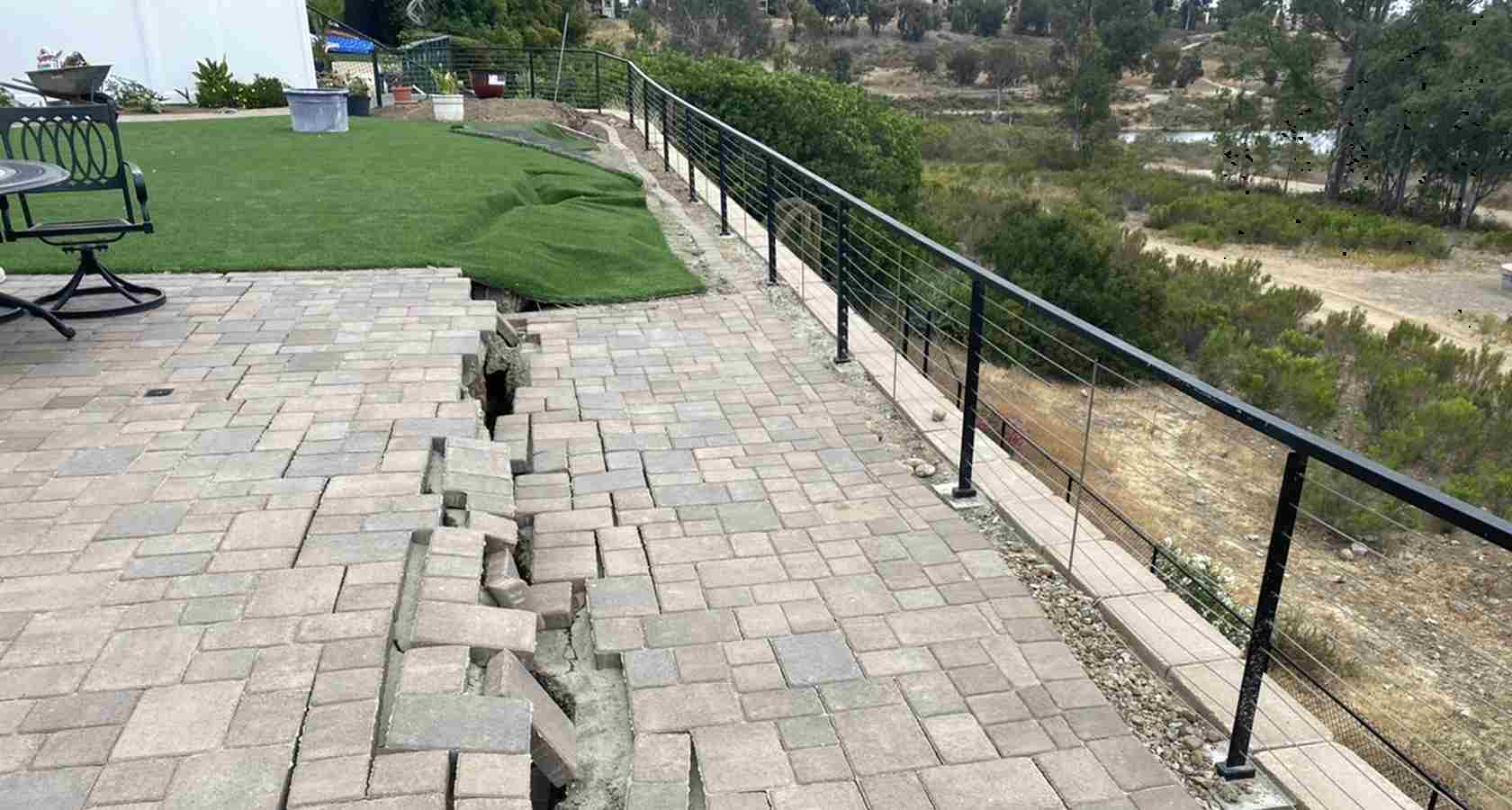
The Retaining Wall Repair Process
Before we dive into cost, let’s cover a typical retaining wall repair process. For this example, our retaining wall is 50 feet long and 8 feet high/deep.
The retaining wall is beginning to lean because it is no longer able to hold the load. The engineer you hired has written up plans to utilize helical piers, helical tiebacks, and a waler beam.
One Helical Pier and one helical tieback will be utilized in conjunction every 8-10 feet. The helical pier protects against downward movement. The helical tieback protects against lateral movement.
Both are driven into competent, load-bearing soil that can sustain the heavy loads placed upon them.
Helical piers, for example, have a max capacity of 74,000 pounds and Helical Tiebacks have a mass capacity of 74,000 pounds – that’s a helluva lot of combined load capacity.
The waler beam acts as a brace. The waler beam is placed 2/3rds way up the wall and spans the entire length of the Helical Pier/Helical Tieback section.
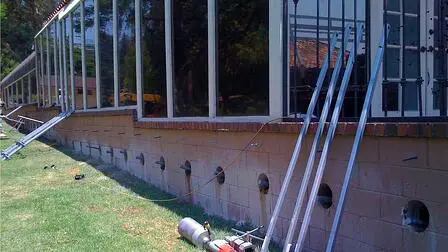
Example of Core Holes
The waler beam extends two extra feet on each side for a total of 4 extra feet.
Waler beam is not always necessary for the repair, which can lower the cost significantly.
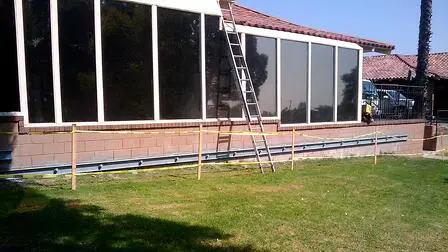
Example of Waler Beam
In short, the helical piers/tiebacks provide additional lateral load-bearing support and are further braced by the waler beam, providing the entire wall with considerable reinforcement.
Retaining Wall Cost Factors
Services Cost
Demolition
Waler Beam
Coring
Helical Piers
Helical Tiebacks | $100-330 per sq. foot
$150-350 per foot
$300-500 per location
$2100-3000 per pier
$2,200-3000 per tieback |
The Retaining Wall Repair Cost Calculation
When it comes to retaining wall repair, this can vary from simply epoxying some cracks to implementing helical tieback and helical piers, making the range in price considerable.
So, for our example, we will utilize an imaginary wall that requires an extensive overhaul.
Let’s say that our wall is 8 feet tall and 50 feet long.
On average, 1 Helical Tieback and 1 Helical Pier will be utilized in conjunction once every 10 feet.
50 ft / 10ft = 5 HT/HP locations
For each HT/HP location, there is a coring fee of say $300.
5 HT/HP Locations x $300 = $1,500
Then, we need to add a price for each HT/HP grouping:
Helical Piers ($2,100 to $3000) + Helical Tiebacks ($2,200 to $3000) x 5 = Y
For this example, we will utilize the lower end of helical tiebacks to compensate for the possible variation in feet depending on the engineer’s plans (meaning fewer helicals might be required rather than more). So, we take $2,100 + $2,200 = $4300 per location which is 5.
$4,300 x 5 =$21,500
Then we factor in $200 per foot x 50 feet for the waler beam = $10,000
In total, we have:
Coring HT/HP Combination Waler Beam Total | $1,500 $21,500 $10,000 $33,000 |
Note – Waler beam is only necessary on very old walls where the structural integrity of the wall is incredibly compromised.
After you have a retaining wall put in or repaired, it is always a good idea to ensure you have good drainage: french drains, weep holes, surface drains, and/or a V ditch.
Recap over the Information You’ve Retained
Alright, so you’re retaining a lot of information right now. The point is that retaining walls are a favorite option for slope stabilization.
They cost a pretty penny, but when you compare it to the final price tag of your house, it’s a mere percentage of what you could lose.
Trust me. We’re kind of like the Farmer’s Slogan, we know a thing or two because we’ve seen a thing or two.
If you live in Southern California or Central Arizona, click the link below for a FREE retaining wall inspection/quote from our Dalinghaus Specialists. –

